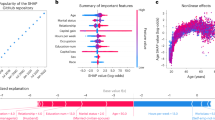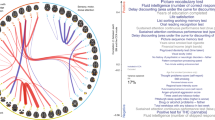Abstract
Deep neural networks are famous for their high prediction accuracy, but they are also known for their black-box nature and poor interpretability. We consider the problem of variable selection, that is, selecting the input variables that have significant predictive power on the output, in deep neural networks. Most existing variable selection methods for neural networks are only applicable to shallow networks or are computationally infeasible on large datasets; moreover, they lack a control on the quality of selected variables. Here we propose a backward elimination procedure called SurvNet, which is based on a new measure of variable importance that applies to a wide variety of networks. More importantly, SurvNet is able to estimate and control the false discovery rate of selected variables empirically. Further, SurvNet adaptively determines how many variables to eliminate at each step in order to maximize the selection efficiency. The validity and efficiency of SurvNet are shown on various simulated and real datasets, and its performance is compared with other methods. Especially, a systematic comparison with knockoff-based methods shows that although they have more rigorous false discovery rate control on data with strong variable correlation, SurvNet usually has higher power.
This is a preview of subscription content, access via your institution
Access options
Access Nature and 54 other Nature Portfolio journals
Get Nature+, our best-value online-access subscription
$29.99 / 30 days
cancel any time
Subscribe to this journal
Receive 12 digital issues and online access to articles
$119.00 per year
only $9.92 per issue
Buy this article
- Purchase on Springer Link
- Instant access to full article PDF
Prices may be subject to local taxes which are calculated during checkout



Similar content being viewed by others
Data availability
The simulated data (datasets 1–4) were generated using the code at https://github.com/zixuans/SurvNet/tree/master/Data. The MNIST data (dataset 5) is available at http://yann.lecun.com/exdb/mnist/. The single-cell RNA-Seq data (dataset 6) is available at the GEO repository https://www.ncbi.nlm.nih.gov/geo/query/acc.cgi?acc=GSE87544. The synthetic data used in the NeurIPS paper16 were simulated using the code on https://github.com/zixuans/SurvNet/tree/master/Comparisons%20with%20knockoffs/Scenario%203, and the real datasets were provided by request from its author, Y. Lu. The synthetic data used in the AISTATS paper17 were simulated using the code at https://github.com/zixuans/SurvNet/tree/master/Comparisons%20with%20knockoffs/Scenario%204, and the two real datasets are available at https://archive.ics.uci.edu/ml/datasets/Bank+Marketing and https://archive.ics.uci.edu/ml/datasets/Polish+companies+bankruptcy+data.
Code availability
The code developed for the study of SurvNet is publicly available at the Github repository https://github.com/zixuans/SurvNet. The code for GL and SGL13 is publicly available at https://bitbucket.org/ispamm/group-lasso-deep-networks/src/master/. The code used to construct second-order knockoffs19 and deep knockoffs26 is available at https://github.com/msesia/knockoff-filter and https://github.com/msesia/deepknockoffs, respectively. The code of the algorithm proposed in the AISTATS paper17 is publicly available at https://github.com/jroquerogimenez/ConditionallySalientFeatures.
References
May, R., Dandy, G. & Maier, H. Review of input variable selection methods for artificial neural networks. Artif. Neural Networks 10, 16004 (2011).
Guyon, I. & Elisseeff, A. An introduction to variable and feature selection. J. Mach. Learn. Res. 3, 1157–1182 (2003).
Chandrashekar, G. & Sahin, F. A survey on feature selection methods. Comput. Electr. Eng. 40, 16–28 (2014).
Battiti, R. Using mutual information for selecting features in supervised neural net learning. IEEE Trans. Neural Networks 5, 537–550 (1994).
May, R. J., Maier, H. R., Dandy, G. C. & Fernando, T. G. Non-linear variable selection for artificial neural networks using partial mutual information. Environ. Model. Software 23, 1312–1326 (2008).
Maier, H. R., Dandy, G. C. & Burch, M. D. Use of artificial neural networks for modelling cyanobacteria Anabaena spp. in the River Murray, South Australia. Ecol. Model. 105, 257–272 (1998).
Brill, F. Z., Brown, D. E. & Martin, W. N. Fast generic selection of features for neural network classifiers. IEEE Trans. Neural Networks 3, 324–328 (1992).
Tong, D. L. & Mintram, R. Genetic Algorithm-Neural Network (GANN): a study of neural network activation functions and depth of genetic algorithm search applied to feature selection. Int. J. Mach. Learn. Cybern. 1, 75–87 (2010).
Sivagaminathan, R. K. & Ramakrishnan, S. A hybrid approach for feature subset selection using neural networks and ant colony optimization. Expert Syst. Appl. 33, 49–60 (2007).
Grandvalet, Y. & Canu, S. Outcomes of the equivalence of adaptive ridge with least absolute shrinkage. In Advances in Neural Information Processing Systems 445–451 (1999).
Chapados, N. & Bengio, Y. Input decay: simple and effective soft variable selection. In IJCNN’01. International Joint Conference on Neural Networks Vol. 2, 1233–1237 (IEEE, 2001).
Similä, T. & Tikka, J. Combined input variable selection and model complexity control for nonlinear regression. Pattern Recognit. Lett. 30, 231–236 (2009).
Scardapane, S., Comminiello, D., Hussain, A. & Uncini, A. Group sparse regularization for deep neural networks. Neurocomputing 241, 81–89 (2017).
Zhang, G. P. Neural networks for classification: a survey. IEEE Trans. Syst. Man Cybernet. C 30, 451–462 (2000).
Benjamini, Y. & Hochberg, Y. Controlling the false discovery rate: a practical and powerful approach to multiple testing. J. R. Stat. Soc. B 57, 289–300 (1995).
Lu, Y., Fan, Y., Lv, J. & Noble, W. S. Deeppink: reproducible feature selection in deep neural networks. In Advances in Neural Information Processing Systems 8676–8686 (2018).
Gimenez, J. R., Ghorbani, A. & Zou, J. Knockoffs for the mass: new feature importance statistics with false discovery guarantees. In 22nd International Conference on Artificial Intelligence and Statistics 2125–2133 (2019).
Barber, R. F. & Candès, E. J. Controlling the false discovery rate via knockoffs. Ann. Stat. 43, 2055–2085 (2015).
Candès, E., Fan, Y., Janson, L. & Lv, J. Panning for gold: ‘model-X’ knockoffs for high dimensional controlled variable selection. J. R. Stat. Soc. B 80, 551–577 (2018).
Storey, J. D. & Tibshirani, R. Statistical significance for genomewide studies. Proc. Natl Acad. Sci. USA 100, 9440–9445 (2003).
Benjamini, Y. & Yekutieli, D. The control of the false discovery rate in multiple testing under dependency. Ann. Stat. 29, 1165–1188 (2001).
Heesen, P. et al. Inequalities for the false discovery rate (FDR) under dependence. Electron. J. Stat. 9, 679–716 (2015).
LeCun, Y., Bottou, L., Bengio, Y. & Haffner, P. Gradient-based learning applied to document recognition. Proc. IEEE 86, 2278–2324 (1998).
Kolodziejczyk, A. A., Kim, J. K., Svensson, V., Marioni, J. C. & Teichmann, S. A. The technology and biology of single-cell RNA sequencing. Mol. Cell 58, 610–620 (2015).
Chen, R., Wu, X., Jiang, L. & Zhang, Y. Single-cell RNA-Seq reveals hypothalamic cell diversity. Cell Rep. 18, 3227–3241 (2017).
Romano, Y., Sesia, M. & Candès, E. Deep knockoffs. J. Am. Stat. Assoc. 115, 1861–1872 (2019).
Tetko, I. V., Villa, A. E. & Livingstone, D. J. Neural network studies. 2. Variable selection. J. Chem. Inf. Comput. Sci. 36, 794–803 (1996).
Steppe, J. & Bauer, K. Jr Feature saliency measures. Comput. Math. Appl. 33, 109–126 (1997).
Sen, T. K., Oliver, R. & Sen, N. in Neural networks in the Capital Markets 325–340 (Wiley, 1995).
Yacoub, M. & Bennani, Y. HVS: A heuristic for variable selection in multilayer artificial neural network classifier. In Intelligent Engineering Systems Through Artificial Neural Networks, St. Louis, Missouri Vol. 7, 527–532 (1997).
Garson, D. G. Interpreting neural network connection weights. AI Expert 6, 47–51 (1991).
Nath, R., Rajagopalan, B. & Ryker, R. Determining the saliency of input variables in neural network classifiers. Comput. Oper. Res. 24, 767–773 (1997).
Gevrey, M., Dimopoulos, I. & Lek, S. Review and comparison of methods to study the contribution of variables in artificial neural network models. Ecol. Model. 160, 249–264 (2003).
Mozer, M. C. & Smolensky, P. Skeletonization: a technique for trimming the fat from a network via relevance assessment. In Advances in Neural Information Processing Systems 107–115 (1989).
Karnin, E. D. A simple procedure for pruning back-propagation trained neural networks. IEEE Trans. Neural Networks 1, 239–242 (1990).
LeCun, Y., Denker, J. S. & Solla, S. A. Optimal brain damage. In Advances in Neural Information Processing Systems 598–605 (1990).
Cibas, T., Soulié, F. F., Gallinari, P. & Raudys, S. Variable selection with optimal cell damage. In International Conference on Artificial Neural Networks 727–730 (Springer, 1994).
Hassibi, B. & Stork, D. G. Second order derivatives for network pruning: optimal brain surgeon. In Advances in Neural Information Processing Systems 164–171 (1993).
Dimopoulos, Y., Bourret, P. & Lek, S. Use of some sensitivity criteria for choosing networks with good generalization ability. Neural Process. Lett. 2, 1–4 (1995).
Dimopoulos, I., Chronopoulos, J., Chronopoulou-Sereli, A. & Lek, S. Neural network models to study relationships between lead concentration in grasses and permanent urban descriptors in Athens city (Greece). Ecol. Model. 120, 157–165 (1999).
Ruck, D. W., Rogers, S. K. & Kabrisky, M. Feature selection using a multilayer perceptron. J. Neural Network Comput. 2, 40–48 (1990).
Bishop, C. M. et al. Neural Networks for Pattern Recognition (Oxford Univ. Press, 1995).
LeCun, Y. A., Bottou, L., Orr, G. B. & Müller, K.-R. in Neural Networks: Tricks of the Trade 9–48 (Springer, 2012).
Abadi, M. et al. TensorFlow: Large-scale machine learning on heterogeneous systems (2015); https://www.tensorflow.org/
Acknowledgements
This work was supported by the National Institutes of Health (R01GM120733 to J.L.), the American Cancer Society (RSG-17-206-01-TBG to J.L.) and the National Science Foundation (1925645 to J.L.).
Author information
Authors and Affiliations
Contributions
J.L. conceived and supervised the study. J.L. and Z.S. proposed the methods. Z.S. implemented the methods and constructed the data analysis. Z.S. drafted the manuscript and J.L. substantively revised it.
Corresponding author
Ethics declarations
Competing interests
The authors declare no competing interests.
Additional information
Peer review information Nature Machine Intelligence thanks the anonymous reviewers for their contribution to the peer review of this work.
Publisher’s note Springer Nature remains neutral with regard to jurisdictional claims in published maps and institutional affiliations.
Supplementary information
Supplementary Information
Supplementary methods, results, discussions, Figs. 1 and 2, and Tables 1–11.
Rights and permissions
About this article
Cite this article
Song, Z., Li, J. Variable selection with false discovery rate control in deep neural networks. Nat Mach Intell 3, 426–433 (2021). https://doi.org/10.1038/s42256-021-00308-z
Received:
Accepted:
Published:
Issue Date:
DOI: https://doi.org/10.1038/s42256-021-00308-z
This article is cited by
-
scFSNN: a feature selection method based on neural network for single-cell RNA-seq data
BMC Genomics (2024)
-
Predictor Selection for CNN-based Statistical Downscaling of Monthly Precipitation
Advances in Atmospheric Sciences (2023)
-
Deep neural networks with controlled variable selection for the identification of putative causal genetic variants
Nature Machine Intelligence (2022)



